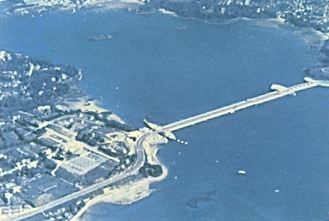|
The tides go in and
out as they are pulled by the moon's gravitational field, and we can capture
energy from this massive movement of water (kinetic energy of the water)
with tidal power stations.

Tidal power stations
are built to stretch over places that are affected by the tides such as
deltas or estuaries. A barrage is set across a beach or river. When high
tide comes in, water flows through a turbine to create electricity. The
water level in the river mouth is now high so a gate is lowered , trapping
the water behind it and preventing it from just going out with the tide.
When low tide comes, the gate is raised and the water flows out, transferring
its energy through turbines. This way, electricity is created with a two-way
turbine.
History
Tidal mills were
invented in the early 1900s. They didn't have two-way turbines then -
they only used one tidal direction. They chose to capture the tides as
they were receding, because there was the most possible outcome from there.
When the tide came in, the floodgate lowered, trapping the water above
it. When low tide came, the gate was lifted up, and the water turned a
water wheel. The wheel could then power the mill.
Advantages
 Running costs are
very low - there are no fuel costs, just maintainance costs Running costs are
very low - there are no fuel costs, just maintainance costs
 Does not produce
greenhouse gases or acid rain Does not produce
greenhouse gases or acid rain
Disadvantages
 Tidal power stations
are very expensive to build - capital outlay is high Tidal power stations
are very expensive to build - capital outlay is high
 They create electricity
only in time with the tides (not when necessarily needed). The energy
from them has to be stored for them to be efficient. They create electricity
only in time with the tides (not when necessarily needed). The energy
from them has to be stored for them to be efficient.
 Many fish, like
salmon, swim up these estuaries where the barrages are and have already
been killed by the turbines. Many fish, like
salmon, swim up these estuaries where the barrages are and have already
been killed by the turbines.
 Building the barrage
can destroy plants and the homes and food supply of many birds, fish
and other animals (change the ecosystem). Building the barrage
can destroy plants and the homes and food supply of many birds, fish
and other animals (change the ecosystem).
 They also can trap
pollutants up stream which damages the environment They also can trap
pollutants up stream which damages the environment
|